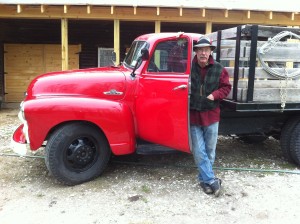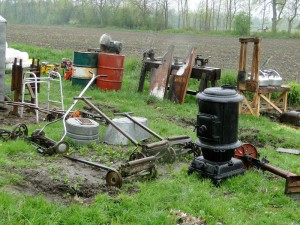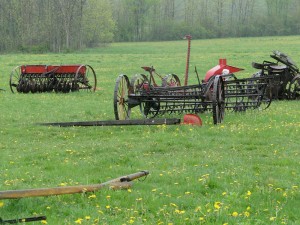The Amish move
Last week, my husband and I helped our friends and neighbors, Abe and Lizzie and their eight children, move from our road where they had been
renting a farm to a farm they have just purchased about 10 miles away. It took a day and half to move everything. It was a joy to be a part of the process.
A crew of about ten Amish men were stationed at the old place, loading trucks, trailers and wagons, and another crew of about 10 were at the new farm, unloading and sorting boxes for kitchen, bedrooms, barn and shop. At each location a team of women organized boxes, oversaw the handling of furniture and other cherished items, and the multiple meals and snacks provided for the crew. (Okay, foodies, these meals included: homemade breads, cakes, cookies and puddings, homemade bologna, cheese, salads of several varieties, and lots of hot, weak coffee.)
Bill and I, along with another couple, were the only “English” involved and we
were all drivers, ferrying belongings from the old farm to the new one.
At both farms, swarms of kids helped move boxes and tools, ran around from porch to shop to yard, and treated the occasion as a community festival.
Years ago, when Amish families started to move into the DeKalb-Depeyster area from (mostly) Ohio and Ontario, I assumed these new neighbors were deeply traumatized by having to find new farms hundreds of miles away from their traditional communities. While moving may separate family segments, I have since learned that 1) Amish people often travel to visit family members who live far away; and, 2) the average Amish family will move several times.
But I’m no expert on the Amish life. So, I asked Karen Johnson-Weiner, the
author of books and scholarly papers on the subject, to help me out on this topic of the Amish and moving. (Abe and Lizzie, we know, have moved several times and they are now in their mid-30s.) Here’s what Karen had to tell me about moving:
“An Amish person can expect to move at least three times. The first move will come at marriage, when the young couple leaves their childhood homes to begin a life together. Their first home is often a “skid house,” the Amish equivalent of a mobile home. This is a temporary residence, often located on a farm where the young man is working. The couple stays in this temporary dwelling or in a rented home until they can save enough money to buy a farm. For the Amish, especially for those in more conservative groups, farming is the ideal lifestyle, for it allows family members to work together. The couple will stay on the farm, raise a family, and then, when most of the children have married and the parents are ready to retire, they build a “dawdy haus” or “grandparents home” next to the main farm house and sell the farm to one of the children—often a younger child who is still renting elsewhere. The parents have an auction to sell farm and household items they no longer need now that they are not actively farming, and the proceeds support them in their retirement.
This pattern means that a farm will often remain in the same family for many generations.
The pattern breaks if the family decides to join others in establishing a new
settlement. This may happen if the community feels there’s no longer enough available farmland, but there are other reasons for moving. For example, the Amish have come to New York State to escape political conflict or difficulties with the local, non-Amish community; to reinforce, maintain, or change their respective church disciplines; to maintain standards for the young folk; to escape turmoil within the church-community; or to avoid the temptations of modernization.
When an Amish community moves a long distance, items will be loaded on semi trucks and taken to the new home. Swartzentruber (and other conservative Amish) families follow by bus. If the move is local, items are hauled by horse-drawn wagons or in trucks driven by English (non-Amish neighbors). In either case, friends and extended family members help the family pack, move, unpack and resettle.”
There was a time, of course, when people in rural areas might expect to live and die in the same home or on the same farm, perhaps moving just once when they married. How does your “moving” life compare with the old days, or with the Amish average of three moves? How many times have you moved? While I’ve lived at my current farm for decades (except for one year-long temporary move), I managed to move ten times before I settled in the north country. Count them up. It’s surprising how mobile we all are.










.jpg)

I lived in the same community in Western NY for the first 47 years in my life, moving locally 5 times. Since then, I relocated to Colorado where I moved 7 times in 8 years. I moved to the North Country 15 years ago and changed locations 8 times. (Totalling 22 moves.)
I do believe I have moving down to a science!
I know I’ll move at least one more time before I ‘kick’, perhaps more. Who knows where the wind will lead me?
Have lived on this farm 24 years. Before that, Delaware- 10 years- alaska- pennsylvania- quebec. I want to settle. The amish just moved out of our tenant house. They had wagon after wagon going just a few miles. Yes, they are much less sentimental- which cuts both ways.
The last two significant groups to move TO the North Country were the “back-to-the-land hippies” and the Amish. They both came here intentionally for the remoteness of this place, the cheap and abundant land, and to escape the trappings of what passes for progress in the urbanized and industrialized world. Both came here to DO something, to create a life, or a trade, or a future. Both have achieved far beyond the local folks who cling to their dead towns and trailer houses for no particular reason, waiting for someone to hand them a job.
When we talk about kids moving away, or folks coming in, it might be useful to know who we’re talking about.
Born in Finger Lakes region almost exactly 8 months to the day after US entered WWII. By the time entered grade school I am told we had moved about 1/2 dozen times. From grades 1 to 8 went to 5 schools in two states 4 more schools from 8-16. Total living steads, exceeding 6month duration, in excess of 30 in slightly less than 70 years with three of them comprising nearly 1/2 of my lifetime. Ten years happily ensconced on second farm in North Country where it is my intent to stay till my last breath.